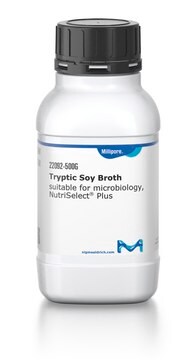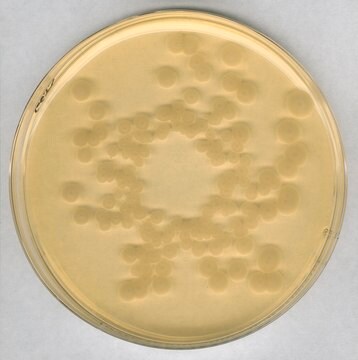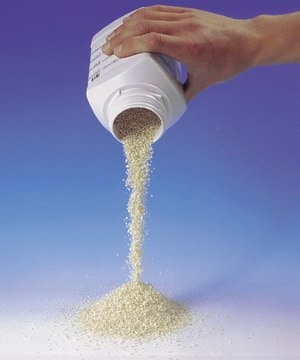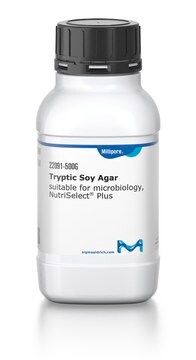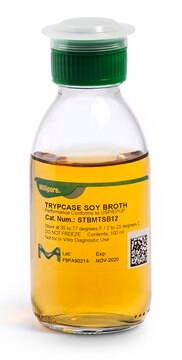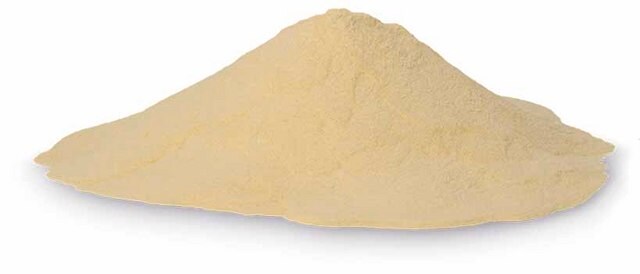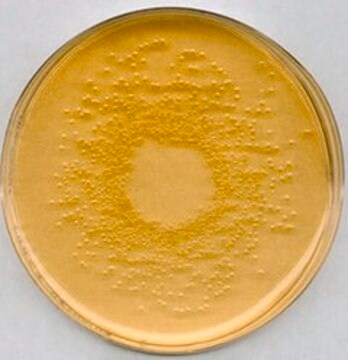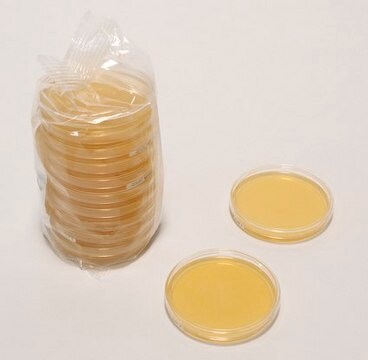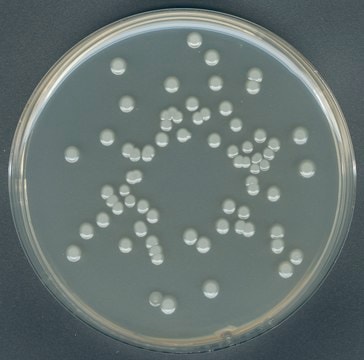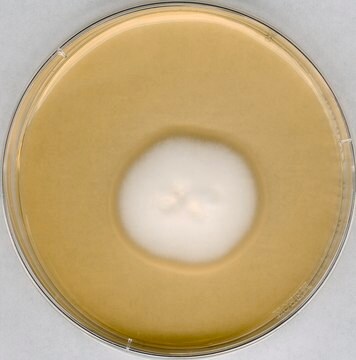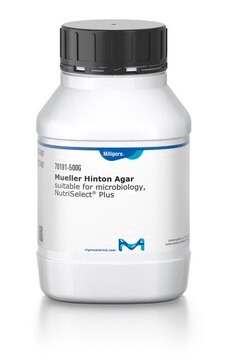Kluczowe dokumenty
22091
Tryptic Soy Agar - Dehydrated Culture Media
NutriSelect® Plus, powder, suitable for microbiology
Synonim(y):
CASO Agar, Soybean Casein digest Agar, TSA, Tryptone Soy Agar, CASO Agar, Soybean Casein digest Agar, TSA, Tryptone Soya Agar
About This Item
Polecane produkty
agency
according to GB 4789.40-2016
according to ISO 11731:2017
according to ISO 22964:2017
Poziom jakości
sterylność
non-sterile
linia produktu
BioChemika
Postać
powder
okres trwałości
limited shelf life, expiry date on the label
skład
agar, 15 g/L
casein peptone (pancreatic), 15 g/L
sodium chloride, 5 g/L
soya peptone (papainic), 5 g/L
opakowanie
bottle of 2.5 kg
bottle of 500 g
producent / nazwa handlowa
NutriSelect® Plus
metody
microbe id | specific enzyme detection: suitable
microbiological culture: suitable
kolor
light yellow
pH końcowe
7.3±0.2 (25 °C)
Zastosowanie
agriculture
bioburden testing
cleaning products
clinical testing
cosmetics
environmental
food and beverages
personal care
surface monitoring
veterinary
microbiology
przydatność
Enterococcus spp.
Haemophilus spp.
Pneumococcus spp.
nonselective for Bacillus spp.
nonselective for Bacteroides spp.
nonselective for Campylobacter spp.
nonselective for Candida spp.
nonselective for Cronobacter spp.
nonselective for Escherichia coli
nonselective for Neisseria spp.
nonselective for Staphylococcus spp.
nonselective for Streptococcus spp.
nonselective for bacteria (General Media)
nonselective for coliforms
Szukasz podobnych produktów? Odwiedź Przewodnik dotyczący porównywania produktów
Opis ogólny
Zastosowanie
Cechy i korzyści
- Quality control with growth promotion test according to industry standards
- Quality assurance acc. to ISO 9001
- Cost-efficient powdered media
Uwaga dotycząca przygotowania
Przypis
The designations basic, plus, or prime are added to indicate the quality control level, from basic quality control to standard QC plus to prime for full regulatory compliance.
Informacje prawne
Kod klasy składowania
11 - Combustible Solids
Klasa zagrożenia wodnego (WGK)
WGK 3
Temperatura zapłonu (°F)
Not applicable
Temperatura zapłonu (°C)
Not applicable
Środki ochrony indywidualnej
Eyeshields, Gloves, type N95 (US)
Wybierz jedną z najnowszych wersji:
Masz już ten produkt?
Dokumenty związane z niedawno zakupionymi produktami zostały zamieszczone w Bibliotece dokumentów.
Klienci oglądali również te produkty
Produkty
Chronobacter spp. Classic and New Detection Methods
Vibrio Detection
Większość wibrysów wykorzystuje proste źródło C, takie jak glukoza, jako źródło energii i wymaga 2-4% NaCl lub innych soli i pierwiastków śladowych obecnych w wodzie morskiej dla optymalnego wzrostu. Niektóre gatunki mogą wykorzystywać różne źródła energii.
On the Trail of Campylobacter
Nasz zespół naukowców ma doświadczenie we wszystkich obszarach badań, w tym w naukach przyrodniczych, materiałoznawstwie, syntezie chemicznej, chromatografii, analityce i wielu innych dziedzinach.
Skontaktuj się z zespołem ds. pomocy technicznej